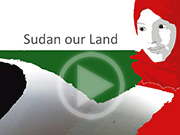Embassy of the Republic of the Sudan in Berlin
سفارة جمهورية السودان ببرلين

Sudan has been inhabited for over 70,000 years, with settlements appearing around 8,000BC.
The Land and the People
![]() Sudan, situated in Northeast Africa is a country of immense diversity that fascinates and intrigues most of its visitors from anthropologists and archeologists to historians and average travelers. It is a country that is unique and complex in its climate, politics, environment, languages, cultures, religion and ethnicities.
Sudan, situated in Northeast Africa is a country of immense diversity that fascinates and intrigues most of its visitors from anthropologists and archeologists to historians and average travelers. It is a country that is unique and complex in its climate, politics, environment, languages, cultures, religion and ethnicities.
Sudan is the third largest country on the African continent with a total area of 1,882,000 sq km. The country has international borders with 7 states : Egypt, Eritrea, Ethiopia, South Sudan, Central African Republic, Chad and Libya. The River Nile traverses the country from South to North while the Red Sea washes about 550 miles of eastern coast making Sudan a bridge between Africa and the Middle East.
While the population of Sudan predominately descends from both indigenous African groups and Arabs, today most tribes in the country speak Arabic and the Arab culture predominates. Over 97% of the population of Sudan is Sunni Muslims with a small Christian minority.
History and Politics
The ties between Sudan and Egypt
From around 800BC, it was the turn of rulers in Sudan to conquer Egypt. From an area known as 'the Kush', the Kushite king conquered Upper Egypt. The Kushites were eventually pushed back and moved their capital south to Meroe. The kingdom's pyramid tombs, palaces and temple remains can still be seen along the Nile.
A new millennium
When Arab warriors began arriving from Egypt, the Nubians made an arrangement with them. Arab Muslims would agree not to settle in the region, if Nubians stayed out of Egypt. This treaty lasted hundreds of years, though with Arab merchants trading along the Nile, the two peoples inevitably mixed and intermarried.
The Muslim era truly begins
During the sixteenth century, a people called the Funj became dominant in the region. Their leader converted to Islam and the Funj Empire became known as the Sultanate of Sennar (the capital).
In 1820, northern Sudan was again invaded from Egypt, which was then part of the Ottoman Empire. The sultan’s third son was sent to rule Sudan, which was valued as a route for slaves and gold out of Africa.
Kicking out their rulers
When the British took over Egypt, they also occupied Sudan to protect the Nile waters. Defeating the Mahdists in 1898, the British gave Sudan its own status. However, the north and south were run separately until 1947. Nine years later, Sudan became independent in 1956.
Fact and Figures
| Meaning of Country’s name | From the Arabic Bilad as-Sudan, “Land of the blacks”. Originally referred to most of the Sahel region |
| Capital | Khartoum |
| Largest Cities | Omdurman, Khartoum, Port Sudan, Kassala, El Obeid, Nyala, Wad Medaniy |
| Population | 30,900000 (2012 est) |
| Country Code | 249 |
| Internet Country Code | .sd |
| Area | 1,882,000 sq km. |
| Area-Comparative | Slightly more than one-quarter the size of the US |
| Bordering Countries | Egypt, Eritrea, Ethiopia, South Sudan, Central African Republic, Chad and Libya. |
| Date of Founding (Current State) | January 1, 1956 |
| Type of Government | Federal Presidential Democratic Republic |
| Languages Spoken | Sudanese Arabic, English |
| Religions Practiced | Islam (70%), Animist (25%), Christian (5%) |
| GDP per Capita | $2,600 (2013 est) |
| Latest GDP Growth Rate | 3.9% (2013 est) |
| Top Exports | Oil-Petroleum Products, Cotton, Sesame, Livestock, Groundnuts, Gum Arabic, Sugar |
| National Holidays | Independence Day – January 1, Coptic Christmas – January 7, Al-Mowlid Al Nabawi (Birth of the Prophet) – February 26, Coptic Easter – April 28, Revolution Day – June 30, Eid al-Fitr (End of Ramadan) – September 11, Eid al-Adha (Feast of Sacrifice) – November 17, Islamic New Year – December 7, Christmas Day – December 25 |
| Money Currency | Sudanese Pound (SDG) |
| National Sports Teams | Sudan Davis Cup Team, Sudan National Basketball Team, Sudan National Football Team |
| Random Fact | Sudan’s flag, which reflects the Pan-Arab colors- was adopted on May 20,1970 |

